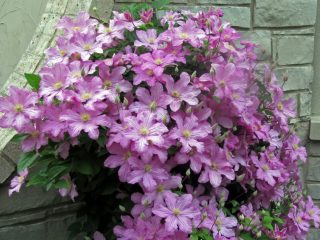Content
Lilies are ancient plants, more than three thousand years old. In Orthodoxy they were compared to a symbol of purity. The chambers of princes and the main monasteries were even decorated with culture. Nowadays, about 100 representatives of this ancient family are known. Lily Henry is one of them.
History of selection
The species appeared in China, however, it was noticed and classified not by Asian scientists, but by the Irish breeder Augustine Henry. The man was selecting the most beautiful plants for the Royal Garden, and his gaze fell on a bright lily, which later inherited the name of the discoverer. At the turn of the 19th and 20th centuries, it migrated to Britain, and then spread throughout the world.
Description of Henry's lily with photo
The species is a perennial. Unlike other lilies, Henry can reach more than 200 cm in height. The peduncle always bends under its own weight. It is characterized by a dark green color, dotted with clearly visible inclusions. The stem is covered with the finest plant hairs.
In adult lilies, leaves can grow up to 20 cm. As a rule, they have a curved structure; in rare cases, Henry's leaves are straight. The Henry Lily has beautiful drooping flowers that reach about 8cm in diameter.They are collected in numerous (up to 16 pcs.) groups located on one peduncle.
The petals have the characteristic roundness of Liliaceae; at the ends they bend. The buds have an orange-gold color, as well as several branched shoots that start growing from the very base of the plant. In the middle part of the flowers there is a bright green stigma, adjacent to which are stamens 5 cm long.
The fruit is a small greenish capsule. It can have different sizes - from 7 to 12 cm in diameter. Contains dark seeds inside.

The outside of the box is covered with dense plates that can be purple or burgundy
Features of flowering
The budding process starts in late summer - early autumn. Pollination occurs with the help of insects, which, like a magnet, are attracted by the smell of nectar and the bright color of the flowers.
Winter hardiness of Henry lily
The plant has good winter hardiness, which became the reason for relocation to colder areas. Henry's lily can be grown in the Moscow region and central Russia.
Advantages and disadvantages
Culture has become widespread in landscape design. It is actively used to decorate parks, school gardens, alleys, and memorial places.

The plant has a strong immune system that provides normal protection against diseases and insects
Pros:
- a large number of buds;
- fast growth;
- possibility of growing in different substrates;
- pleasant aroma;
- winter hardiness.
Minuses:
- the need for frequent fertilizing.
Planting Henry Lily
The flower can be called, without exaggeration, capricious; it needs the right growing technology.You can plant Henry lily at home or in open ground. Whatever the gardener chooses for himself, the main thing is to prepare the planting material.
Bulbs must have the following characteristics:
- weight from 40 to 45 g;
- absence of stains, growths;
- elasticity.
They also check for deformations and a strange smell. If your Henry lily smells damp, it is probably rotting. There is no point in using it for planting. The next step is stratification - the material is wrapped in slightly moistened moss and placed in the refrigerator for 15 days.
After the specified period of time, the Henry lily is soaked in a solution of potassium permanganate and then immersed in a root development stimulator. Only now can you start planting. The substrate is provided with a sandy layer - drainage. Work is carried out when the temperature is above +8 degrees.
The soil chosen is loose and fertilized. If the Henry lily will be at home, use a 3-4 liter clay or ceramic pot.
Henry Lily Care
The first thing to remember is that the Henry lily needs to be watered regularly. The soil should be about 30% dry (between each moistening). It is not advisable to use tap water because it contains a lot of sediment. Therefore, the liquid is first left to settle for about a day and then used.

Water at the root, being careful not to wet the shoots - this can lead to burns.
When the flowers begin to fade, moisten less frequently.
As for fertilizing, the gardener will have to use it very often.As soon as the lily wakes up from winter sleep, the first addition is added. Subsequent feedings are carried out twice a month. In spring, the emphasis is on nitrogenous mixtures, as they help build up green mass. At the end of summer, when budding begins, phosphorus-potassium fertilizers are used.
Liquid formulations are better absorbed, so they are preferred. Of course, complex fertilizers also work well; most gardeners recommend them. Before each application, the soil must be loosened.
Another important point is lighting and temperature. The bright colors of the Henry lily reflect its love of sunlight. The pot must be placed on a bright window. But it is advisable to avoid direct rays.
The temperature is maintained within 20-25 degrees. In order for the flower to breathe, they try to ventilate the room more often or take the pot outside.
The Henry lily should be pruned 1-2 times a year. They do this, firstly, for sanitary prevention, and secondly, to increase the duration of flowering. In the spring, damaged, dry shoots are found and removed with a sharp object. And in the fall, when the flowers begin to fall off, they help the plant get rid of them faster, this stimulates the formation of new inflorescences. The knife must be treated with potassium permanganate.
The domestic Henry lily is almost never grown for cutting. But if you are guided by this goal, it is better to purchase pruners. With its help, 1/3 of the stem is left.

The tool is also useful for preventing seed set
There is no need to replant the plant annually; it can grow in the same soil, provided that the gardener regularly fertilizes the substrate. If necessary, replanting wait until after flowering.Then the Henry lily is moistened for the last time and removed from the soil with a lump of earth. In the new place, water again.
Reproduction
In the wild, the Henry lily reproduces using seeds and bulbs. At home, children use them - they are carefully cut from the mother bush and transplanted into another container. The raw material is buried 2 cm, its upper part should be outside.
When reproducing, you must pay close attention to the process. If during the mother plant the children received the moisture and substances necessary for growth, then after transplantation these same conditions should be recreated.
The bulbs may be small, in which case it is recommended to wait until they get stronger and only then separate them from the main plant
Conclusion
Henry Lily is an interesting representative of its genus, distinguished by its large size and fiery color of the petals. Growing a crop can be compared to caring for roses: it is just as difficult, however, if you get used to agricultural technology, the plantings will always be large and healthy.
Reviews of Henry's lily









